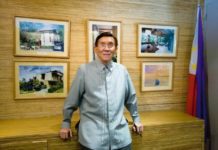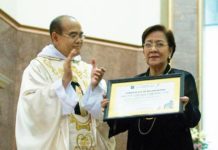THE CALL for priesthood comes in mysterious ways. But for these two Thomasian archbishops, it is the beginning of fulfilling a greater mission: to be the shepherds of a bigger flock.
Archbishops Leonardo Legaspi of Nueva Caceres and Onesimo Gordoncillo of Capiz were graduates of Sacred Theology. But before they were sent out to herd the faith of their respective archdiocese, Legaspi and Gordoncillo assumed many roles that changed the course of their destiny.
First Filipino Rector
Legaspi became the first Filipino Rector of UST in 1971 and the Central Seminary in 1968, succeeding the leadership of many Spanish rectors.
In Dr. Norberto de Ramos’ book I Walked with Twelve UST Rectors, Legaspi’s installation as rector completed the Filipinization of the University at the top positions. However, he was criticized for being pro-Spaniard because of the slow total FIlipinization of administrative positions in the University. De Ramos wrote Legaspi was not to be blamed because this was due to lack of Filipino Dominicans in the University.
Under his rectorship, Legaspi implemented the new rule of granting honors to graduating students using the weighted average system, the opening of short-term courses, and the translation of the heading of all diplomas to Filipino.
With several staff meetings, conferences, problems to attend to and trips abroad that go with his position, Legaspi said he was clueless that “a rector could be, or should be, so busy.” Despite this, he assumed his responsibility efficiently.
“In dealing with problems, he was cool, patient and unfazed by their enormity,” de Ramos wrote. “I never saw him show outward anger or shout at an employee.”
From being the administrator of the University, little did he know that he was destined for a bigger responsibility¬—to be the overseer of a greater flock.
His installation as the archbishop of the Archdiocese of Nueva Caceres in Naga City in 1984 was described by many as “Manila’s loss and Naga’s gain” after leaving his post as Manila Auxiliary Bishop.
For Legaspi, who spent many years of his priestly life in the academic world, administering an archdiocese was no easy feat.
Having gotten used to being an academician, Legaspi struggled with his unfamiliar task as an archbishop due to lack of pastoral experience. After all, Legaspi was a Theology professor for 14 years.
“Except for occasional masses in the parish, I had no practical knowledge of the parish life,” he told the Varsitarian. “Many bishops came from the parish and managed the diocese as a parish priest.”
To make up for this inexperience, he used his skills in university administration to lead his archdiocese.
“In this context [coming from the academic world], I used the experience in management and looked at the Archdiocese in that light,” said Legaspi, who also served as Catholic Bishops’ Conference of the Philippines President from 1987 to 1991. “At the same time through the years, I got to learn the intricacies of pastoral service.”
Path to God
Just like most birth stories of religious vocations, his priesthood started from a sense of confusion and dissatisfaction with one’s life.
Legaspi initially wanted to enter the Philippine Military Academy after high school, but ended taking up Civil Engineering at the University of the Philippines despite not being a “math person.”
“I ended up making good marks in humanities and disastrous grades in math and drawing,” he said. “Then, I enrolled [in a Pre-Law course] at UST and did better.”
But it was after a basketball game at a seminary which drew him to his calling.
“I was struck by the deafening silence of the seminary atmosphere,” Legaspi said. “When I came home I spoke to my father about this deep feeling for the seminary.”
This “deep feeling” soon commenced his future vocation that led him to the Dominican Monastery of St. Albert in Hong Kong. The rest is history as they say.
In 1974, during his rectorship at UST, he received awards from different institutions, including the Ten Outstanding Young Men award for Education and the Gran Cruz de Alfonso X El Sabio of the Spanish Government.
In the years of his vocation, Legaspi said “beyond doubt” being an archbishop is the biggest responsibility aside from every priest’s formidable task of self-reform and self-knowledge.
Preacher teacher
Despite the superstitions and “supernatural” beings in the auspices of
Capiz, the province is still blessed with an archbishop whose pastoral experience and pedagogical background help in strengthening the faith of the flock.
Gordoncillo has been serving as the archbishop of Capiz for more than two decades with luck that seemed to be always at his doorstep. Being sent to places with not relatively different cultures and languages like Tagbilaran, Bohol helped him adjust easily to the new atmosphere of Capiz.
“I was talking to them [the faithful] in their language which I learned when I studied in Bacolod,” Gordoncillo said. “I was really thankful to the Lord for preparing things easier for me.”
Gordoncillo’s religious vocation was a fulfillment of both his dreams as a priest and as a teacher.
“I always loved teaching and was inspired by my teachers who were so good and kind to me,” the Philosophy teacher said.
Before he was assigned to the parish of Dauin, Negros Oriental in 1969, he was a professor at the St. Joseph Seminary in Dumaguete City and later became its rector. But there was a balance between his academic and pastoral experiences when he started working as assistant parish priest where he learned the ways of pastoral life. From then on, Gordoncillo glided his way to higher posts as a priest, a bishop, and now an archbishop.
“It’s not easy to be assigned to many places because you have to deal and adjust to different people,” he said. “But, people were mostly cooperative.”
However, not everything turned out so well for Gordoncillo. He dealt with homesickness as he studied at the UST Central Seminary from 1954 to 1961.
Just as any other typical college student story, being sent to study in Manila after high school was a first for him to be away from his family.
Aside from homesickness, financial problems also hounded Gordoncillo—a matter which beset his family even during his high school days at the Sacred Heart Seminary in Bacolod City.
“There was also a temptation to get out of the seminary because maybe, it was too much for my parents to spend for me,” he said.
But through prayers and the blessing of his benefactor, he was able to sustain his stay in the seminary and respond to God’s call as a priest and later an educator.
With their long years of service as an archbishop, Legaspi and Gordoncillo, now enriched by two different worlds of the academe and the parish, with brimming passion for their vocation, they serve the Lord as teachers and stewards of His flock. With reports from Maria Joanna Angela D. Cruz









